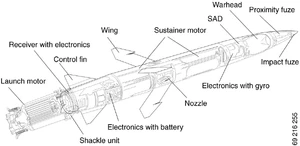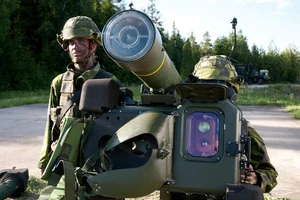The RBS 70 (Swedish: Robotsystem 70, lit. "missile system 70") is a Swedish-designed surface-to-air missile system. It uses semi active command line of sight (SACLOS) guidance, specifically line-of-sight beam riding (LOSBR). It was the first operational MANPADS system to use this guidance method.
History[]
The RBS 70 was developed by Bofors Defence starting in 1967 as a replacement for a series of obsolete systems in use by the Swedish military at the time: specifically, the MIM-23 Hawk SAM (RBS 67 and 68 in Swedish service), FIM-43 Redeye MANPADS (RBS 69) and 40mm Bofors antiaircraft guns. The first operational prototypes were delivered for evaluation in 1973, with over 100 test firings occurring over the next two years. An order for full production was placed in June 1975: with further refinements, the system was declared operational in 1977.
In 1982 the second-generation system was introduced with improvements to area coverage, with the third-generation launcher following in 1990. The Gen 3 launcher incorporated the Mk 2 missile and two new modules, an optional thermal sight called the clip-on night device (COND) and the Battlefield Management Terminal.
The improved BOLIDE missile debuted in 2003 along with the improved Thermosight BORC night device and the Raytheon Cossor IFF880 IFF antenna. As well as this, launchers were updated, replacing the old Freon-cooled laser system with one using uncooled laser diodes. In 2011 a new launcher, the RBS 70 NG, was released specifically designed to fire BOLIDE.
In 2013 the Swedish military expressed a desire to replace RBS 70 with a ground-based version of the IRIS-T air-to-air missile.
Design Details[]
RBS 70 is generally regarded as a MANPADS, though like the French Mistral system it is a "heavy" MANPADS that is portable by a team of 3-4 soldiers rather than a single individual. Once assembled, it can be operated by a single gunner.
The launcher resembles an ATGM system with a large tripod-stand mounted sighting unit to which encased missiles are attached. For transport, it breaks down into a series of loads, with the core of the system able to be transported by three soldiers. One carries the gyrostabilizer sight and power supply, another the stand, and a third carries missiles. Additional modules are carried by a fourth crewman if they are to be used: these can be the COND or BORC clip-on IR sights, the IFF antenna and its support equipment, or the Battlefield Management Terminal. The latter allows launcher teams to network with the truck-mounted Saab (formerly Ericsson) GIRAFFE fire control radar for battery coordination: one GIRAFFE can coordinate up to nine RBS 70s.

RBS 70 launcher with IFF and Thermosight BORC.
IR-guided SAMs of the time were easily spoofed by flares: RBS 70 instead elected to use a SACLOS guidance system. The precise type used, LOSBR, differs from the more familiar semi-active laser homing (SALH) which is usually called "laser guidance." In a SALH system, a laser is pointed at the target and a sensor in the missile's nose detects the light reflected from the target and plots a course to intercept it. LOSBR, on the other hand, places the detector in the missile's tail and has it attempt to fly along the line of the laser beam itself: the beam is a narrow cone rather than a thin line, and is not solid. Rather, it is generated by continuous scanning both vertically and horizontally, many times per second. The missile synchronizes with this scanning on launch, and uses it to work out where it is in relation to the center of the beam, generating course corrections to steer itself to the center.
The system is more finicky, but has the advantage of the missile itself being much less complex, as well as being virtually impossible to jam as the detector is facing directly away from the target.
The operator does not point the entire launcher to aim the laser: instead, it is traversed and elevated to aim the sight in the rough direction of the target prior to engagement, and then a small thumbstick at the top of the right handgrip used for fine aim. This thumbstick controls a gyro-stabilized mirror which directs the laser, and also shifts the point-of-aim of the sight to match. Four LEDS around the perimeter of the sight reticle are used to indicate the deflection limits of the mirror: if one of these flashes, a gentle coarse aiming correction to the launcher will have to be applied to continue tracking the target. A zoom lens in the tracker's optics automatically narrows the beam-cone as the missile gets further away.
Initial target acquisition and coarse aiming is performed using an open-ring diopter sight, after which the operator switches to the telescopic sight for targeting. This is a 7× magnifier with a 9° field of view.
Since the heart of the system is a fairly fragile laser, thick foam pads are present on the corners of the sight unit to make handling easier and protect it if it is dropped. The laser assembly is hermetically sealed and filled with inert nitrogen gas to prevent atmospheric interference with the beam. The original laser was gas-cooled through the evaporation of liquid Freon refrigerant (a CFC), with the internal supply sufficient for several firing sequences after which it would have to be topped up using disposable gas bottles. In 2003 this was replaced by a new system using uncooled laser diodes
The original RBS 70 launcher required the user to manually track the missile to the target for the whole duration of the engagement by keeping the sight's crosshair centered on it: this required a fair amount of training for gunners, as if the missile lost track of the laser it would self-destruct after a short time. The NG version partially automates this in a similar way to the track gate engagement mode added by the ITAS upgrade to BGM-71 TOW, presenting a tracking circle in the sight and allowing the user to designate a target: the internal systems will then perform all fine-aim tracking as long as the target is kept within the wider tracking circle, with the operator only having to provide coarse adjustments.
Unlike the IFF of smaller MANPADS systems like FIM-92 Stinger, the IFF on RBS-70 is integrated into the fire control system, and transmits two automatic IFF challenges: one upon releasing the safety catch, and a second after the trigger is pressed. A friendly IFF response will immediately halt the firing sequence: in the second case, the IFF check is performed before the firing signal is actually transmitted to the missile. A button on the launcher's left grip allows manual challenges to be issued if the operator desires. As the system is not fire-and-forget, the operator can also manually end an engagement at any time by simply turning the system off, which will lead to the missile self-destructing: this occurs automatically if a manual IFF challenge after firing results in a friendly response.
Ammunition[]

BOLIDE missile immediately after launch, wings partially unfolded: note the still-attached launch motor.
Missiles for the RBS 70 are issued pre-packaged in a sealed launch tube, with a built-in handle for short-distance carry, a shoulder strap, two protective shock-absorbing end covers and a connector cover. The connector cover is removed prior to mounting the missile tube on the launcher, and the end caps removed prior to launch. There are a pair of transparent covers on the ends of the launch tube under the end caps, which are not removed prior to launching and pop off as soon as the tube pressurises from the launch motor igniting. For safety, RBS 70 missiles will lock out the system's trigger if the rear end cap has not been removed.
The RBS 70 uses the RB 70 (Mk1), RB 90 (Mk 2) and BOLIDE 106mm LOSBR guided missiles. The Mk 2 represents an incremental upgrade to the Mk 1's performance, while BOLIDE is a much more capable weapon. All missiles use two-stage soft-launch propulsion: like Stinger, this is handled with a launch motor that detaches from the rear of the missile shortly after it exits the tube to arm the main flight circuit. Unlike Stinger, the launch motors of the RBS 70's missiles burn out before they exit the launch tube. The sustainer motor fires a safe distance from the tube and accelerates the missile to full flight speed. The missile does not arm until it is around 820 feet (250 m) from the launcher.

Diagram of RB 70 missile with launch motor attached.
The basic missiles accelerate to a flight speed of Mach 1.6 before flight motor burnout (after 5-6 seconds), while BOLIDE reaches Mach 2.
The warhead of the Mk 1 missile was a fragmentation type with an HE core surrounded by 2,000-3,000 3mm tungsten shot pellets for generating shrapnel. The Mk 2 upgraded this to a combined effects warhead with the same shrapnel layer but the HE element changed to a pair of hollow charges. It is unclear if this gives the system a secondary ability to target light vehicles as with the British Starstreak HVM, as no penetration figures have been published. These two variants both had a dual fuze with impact and laser proximity sensors, with the proximity fuze able to be manually disabled prior to launch if the operator desired.
BOLIDE has a selectable fuze with impact plus two proximity modes, the regular mode or a more sensitive small-target proximity mode for targeting drones and cruise missiles. It also has reprogrammable internal software, allowing for easier guidance upgrades.
Encased missiles have a stated shelf life of around 15 years, with only routine moisture infiltration checks required.
Variants[]

RBS 70 with no COND and early-model IFF system (the large box mounted below and in front of the sight unit).
RBS 70
Basic launcher, with night sight and IFF as optional extras in later variants.
RBS 70 NG

RBS 70 NG. Note differently shaped window on the right (launcher's left). The straps on the other side of the front of the launcher are part of a built-in shoulder harness and waist strap for carrying the sight unit as a backpack.
"New Generation" launcher unveiled in 2011, specifically designed for integration with BOLIDE. Built-in night sighting and improved functionality, including automated target tracking.
ASRAD-R
Vehicle-mounted and naval variant developed by a partnership of Saab Bofors Dynamics and Rheinmetall AG, based on Rheinmetall's existing Advanced Short Range Air Defence System, a vehicle mounted radar and tracking system for the FIM-92 Stinger used by Germany and Greece (ASRAD-HELLAS) The R ("RBS") variant was developed for Finland in 2002 based on BOLIDE prototypes, and combines RBS 70's existing guidance system with an optical day/night tracker to create an automatic command line of sight (ACLOS) system, with the tracker being used to aim the LOSBR laser.
References[]
- RBS 70 Manual, Bofors Defence, 1984